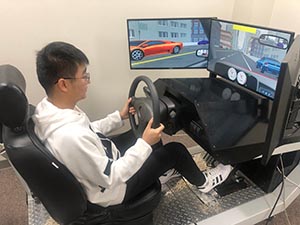Engineering students win awards for innovating the human experience
11/2/2020
By Miranda Buckheit
UNIVERSITY PARK, Pa. — Two graduate students at Penn State have individually received awards from the Human Factors and Ergonomics Society (HFES) during the virtual annual meeting from Oct. 5 to 9 for their work to improve various technical aspects within the field of human factors.
Jessica M. González-Vargas and Zheng Ma, both doctoral candidates, received best paper awards from the Training Technical Group (TTG) and Surface Transportation Technical Group (STTG), respectively.
González-Vargas is advised by Scarlett Miller, associate professor of engineering design and industrial engineering and director of the School of Engineering Design, Technology, and Professional Programs’ (SEDTAPP) engineering design program. Ma is advised by Yiqi Zhang, assistant professor of industrial and manufacturing engineering.
Improving central venous catheterization
González-Vargas, a Bunton-Waller fellow and a National Science Foundation Graduate Research Fellowship Program fellow, explained that her winning paper from the TTG rose from her work with Miller via a study conducted with medical experts to improve their current Dynamic Haptic Robotic Trainer (DHRT) system.
According to González-Vargas, the DHRT was developed to minimize the up to 39% of adverse effects experienced by patients during central venous catheterization (CVC) by standardizing CVC training and providing automated assessments of performance. She noted that with this DHRT system, they aim to facilitate and improve the CVC training process for medical residents with the goal of reducing infection and complication rates in patients.
Specifically, González-Vargas said that the system was developed to replace mannequin trainers that can only simulate one patient’s anatomy and also require a trained reviewer to evaluate the trainees' performance.
While the DHRT system provides automated feedback, the utility of this system with real-world scenarios and expertise had yet to be thoroughly investigated.
“The current study was developed to determine the validity of the current objective assessment metrics incorporated in the DHRT system through expert interviews,” González-Vargas said. “The main findings from this study are that experts do agree on perceptions of patient case difficulty and that characterizations of patient case difficulty are based on anatomical characteristics, multiple needle insertions and prior catheterization.”
González-Vargas said she was motivated to conduct this study because conducting research in “human factors with health care applications is an excellent combination for improving the patient's life.”
“By working on this project, I feel that I am capable of helping the lives of the medical residents as well as the patients,” González-Vargas said. “It is a fantastic feeling to know that I am working and collaborating on a system that will improve other people’s lives.”
Exploring autonomous vehicles and human interaction
Ma’s winning work from the STTG focused on the impact of a driver’s driving style and an autonomous vehicle’s (AV) operation on the driver’s trust, acceptance and takeover behaviors in normal and hazardous scenarios when riding in a fully AV. Their work is funded by the National Science Foundation Computer and Information Science and Engineering Research Initiation Initiative program.
Ma explained that the results reveal that both the AV’s driving style and the driver’s driving style were influential factors on the driver’s trust, acceptance and takeover behavior. Ma noted that the National Motor Vehicle Crash Causation Survey (NHTSA, 2015) showed that 94% of fatalities are caused by human error.
“It is assumed that an AV could reduce this kind of human error and decrease the number of traffic crashes,” Ma said. “Although this technology provides a good performance, there are still a lot of drivers afraid to drive AVs, which suggest that people’s trust and acceptance of AVs needs to be promoted.”
Ma said that fully AV driving styles might align or disagree with drivers’ driving styles. This discrepancy between the driver’s driving styles and the AV’s driving styles may influence the driver’s trust and acceptance of an AV’s driving behavior, which in turn could affect the driver’s takeover behavior frequency and use of AVs.
“We expect drivers to have higher trust and acceptance of AVs and take back control less frequently when the AV’s driving style aligns with the driver’s driving style,” Ma said. “This study provides some insights into the designing of AV. In the future, drivers might be able to customize their own styles of AV based on their driving habits and preference in a standard safety margin.”





